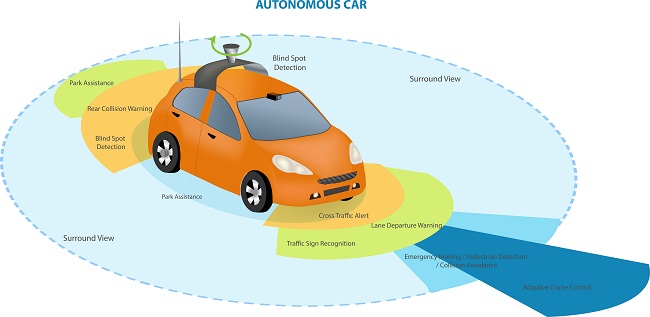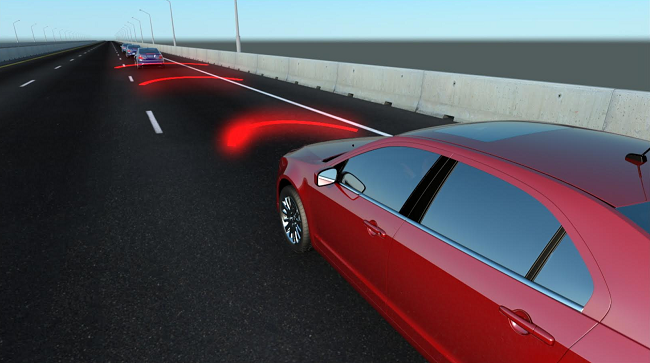The next wave in driving safety: crash avoidance technology
Automakers are looking to technology and data to increase safety in vehicles. Read about the evolution of ADAS and crash avoidance technology.


Compared with how fast the IT industry is evolving, traditionally, auto manufacturers have typically been slower at incorporating advanced safety technology in new models. However, in recent years, automakers have made a complete shift and now focus on technology and data to drive innovation and safety strategy for the future. It’s not only a mission for them, but a quest to be the first in releasing new safety technology like crash avoidance.
New technology like crash avoidance systems, assisted driving, and ultimately, autonomous driving, will significantly reduce crashes, lessen the severity of injuries, and help prevent unnecessary deaths.
The Evolution of Safety Technology
The industry has come a long way from the first universal safety measure of installing seat belts. Volvo introduced the three-point seat belt in Sweden in 1959. Once people realized the effectiveness of seat belts in saving lives, they became a requirement. Europe mandated front seat belts in 1965, and lap and shoulder belts were made standard in the U.S. after the National Highway Traffic Safety Administration (NHTSA) was set up in 1966.
ADAS Takes Hold
Today, automakers and tier one suppliers have fully embraced crash avoidance technology, also known as Advanced Driver Assistance Systems (ADAS). Driver safety technology is featured prominently in advertising — in print, tv, and online. As a result of ADAS solutions, driver experience and overall road safety have already improved.
In North America and other regions, we will see increased use of ADAS in cars and trucks. A market research report published this year predicts that the global market for commercial vehicle ADAS will grow by 14% in the next five years, driven by the rise of connected trucks and platooning. McKinsey has called this the “quiet revolution.” While we all have been distracted by the excitement over autonomous cars, ADAS has been integrated into our vehicles bit-by-bit.

What Are Advanced Driver Assistance Systems (ADAS)?
ADAS are systems designed to help drivers avoid collisions through hazard alerts, or automatic controls such as steering and braking. ADAS technologies are standard in some select vehicles, they can be added as an optional feature, or purchased as an aftermarket product.
Advanced driver assistance systems monitor the area around the vehicle through a combination of cameras, radar, infra-red, ultrasonic, or LiDAR sensors to detect potential threats or danger and then activate a warning or action. Intel calls this process “sensor fusion and situational analysis.”
You may already be familiar with some types of ADAS technology. Many new vehicles already include ADAS features such as adaptive cruise control, blind-spot monitoring, lane departure warning, automatic braking, and backup camera.
Suggested Reading: A World Without Human Drivers: Submitting Vehicle Control to the Power of Telematics
Key Rulings on Safety Technology: Rearview, AEB & ESC
NHTSA ruled back in 2014 that all new vehicles under 10,000 lbs in the U.S. must have “rear visibility technology” by the year 2018 to increase safety and reduce the number of deaths and injuries due to backover accidents. The United Nations World Forum for Harmonization of Vehicle Regulations has given approval for automakers to start building cars with camera systems instead of side and rear mirrors. Japan has just allowed mirrorless cars and the U.S. may follow suit in the next couple years. BMW showcased the i8 mirrorless concept car at the 2016 Consumer Electronics Show.
This past March, NHTSA and the Insurance Institute for Highway Safety (IIHS) announced that 99% of auto manufacturers in the U.S. have agreed to include automatic emergency braking (AEB) systems as a standard feature by 2022 for new vehicles. The impact that AEB will have on preventing and reducing the severity of collisions is pretty significant.
NHTSA projects that AEB can prevent an estimated 28,000 collisions and 12,000 injuries per year. This advancement is just the beginning of what we can expect.
ESC Becomes the Standard
Similarly, electronic stability control (ESC) has been standard for all vehicles and light duty trucks since 2012. Starting in 2017, ESC systems will be required on large commercial trucks and buses. NHTSA estimates the implementation of ESC for large trucks and buses will save the lives of 49 people each year, prevent up to 1,759 crashes and provide a benefit to the economy of more than $300 million annually — all this for the cost of less than $600 for a new tractor.

Photo courtesy of IIHS.
The Case for ADAS: Vehicle Collisions Are Costly to Fleets
Despite changes in vehicle safety standards, motor vehicle crashes are still the number one cause of on-the-job fatalities according to the U.S. Bureau of Labor Statistics.
A startling number of people are still losing their lives on the road each year. In 2015, there were 35,902 deaths due to traffic crashes, according to NHTSA. Fatalities rose by 7.2% over the previous year, which is an unexpected increase. Driver behavior was a major factor in many crashes, including drunk driving, speeding, and distraction. Surprisingly, “half of passenger vehicle occupants killed were not wearing seat belts,” as noted in the U.S. Department of Transportation briefing.
A 2016 report by the Centers for Disease Control and Prevention (CDC) Foundation cites the following statistics:
- Work-related vehicle collisions cost U.S. employers $25 billion, which is broken down as $671,000 per death and $65,000 for a non-fatal injury (2013).
- 36% of work-related injury deaths in the U.S. were caused by motor vehicle crashes (2014).
- 58% of workers who died in vehicle crashes at work were not truck, bus, or taxi drivers or employed specifically as vehicle operators (2014). All types of drivers need to be aware of safety.
- More than a third of long-haul truck drivers has been in a serious truck crash during their career.
The financial impact to businesses runs even deeper when you combine workers’ compensation claims with lost time, the cost of repair and replacement, loss of product, lawsuits, and damage to the company image. All considered, vehicle collisions can result in significant losses to an organization.
Why Fleets Should Consider Crash Avoidance Technology
The sheer volume of miles driven and the number of hours that fleet vehicles and drivers spend on the road are two good reasons to take a closer look at ADAS.
In the recently published 2016-2017 Fact Book on the fleet industry, Automotive Fleet reported concern in the increase of collisions related to driver distraction. Technology continues to be a safety flashpoint.
Safety features are playing a stronger role in determining which vehicles rise to the top for new orders. It’s important for fleet, risk, and safety managers to understand what crash avoidance technologies are available (standard, optional, and aftermarket), when considering safety strategies, and deciding on new vehicle selectors. As ADAS becomes more common, it’s important to review this technology to determine what impact it can have on reducing the number and severity of crashes within your fleet.
Most Common ADAS Technologies
Among manufacturers, there are vast differences in availability of crash avoidance technologies and costs. Crash avoidance features are rapidly making their way into the market and into fleets as both standard and optional features. These features are designed to help drivers operate vehicles more safely.
Six most common crash avoidance technologies you should review:
- Forward collision warning
- Automatic braking and electronic stability control
- Lane departure warning and prevention
- Adaptive headlights
- Blind spot detection
- Back up prevention and park assist
Learning Resources for Advanced Safety Technology
MyCarDoesWhat.Org
To help drivers better understand car safety technology, the National Safety Council and its partner, the University of Iowa, created the educational website MyCarDoesWhat.org. This website can help you find out about new safety features, how the technology works, and how to use it. The site also contains video quick-guides, infographics, games, and deeper learning articles.
According to Alex Epstein, Senior Director of Digital Strategy and Content for the National Safety Council, this website is a wikipedia of available and soon-to-be available safety features, adding: “These safety features help drivers recognize risk and sometimes act when a driver doesn’t react after the risk is identified, but they are not meant to take over the task of driving.” The website is beneficial for all types of drivers and for understanding the varying differences in these technologies.
What may cause confusion is that these features often have different names and functionality among OEMs. For example, automatic emergency braking is also marketed as forward collision mitigation system, pre-crash warning and braking system, and intelligent braking. With some systems, the car may stop completely and with another, the vehicle may only slow down. Detection of pedestrians or bicyclists may or may not be included in the feature.
Capabilities may vary even among the same OEM, making it critical for drivers not to depend solely on these systems for safe driving. “You are your car’s best safety feature,” is the official tagline of the My Car Does What campaign of the National Safety Council — and couldn’t ring more true today.
These technologies assist the driver by providing warnings and alerts for obstructions and the environment around them, and can assist with automatic controls and braking to avoid a crash. They can range in function from increased braking and adjusted steering response, with full automation to brake and steer the vehicle if the driver does not take action.
IIHS Crash Avoidance Technologies Website
The Insurance Institute for Highway Safety (IIHS) offers a valuable tool to search crash avoidance systems by make and model at the IIHS Crash Avoidance Technologies website. You can also access crash prevention ratings and research on the site. Search 2016 and Ford, and you will see every model from the 2016 Ford Edge 4dr to the 2016 Ford Transit Connect van SWB, and which safety features are standard, optional, or not available for each.
The Importance of Educating Drivers on Safety Features
As important as these features can be in your quest to assist drivers with increased safety, it’s wise to also use caution. There have been several reports indicating that these features, although proven to increase safety behind the wheel, can also be annoying and confusing to drivers. In turn, drivers may choose to “turn off” or simply ignore these important safety features.
According to research, the feature most commonly turned off is lane departure warning. Given NHTSA’s report that these systems can reduce the number of lane and road departure crashes by 26.1% and reduce serious injury to drivers by 20.7%, it’s imperative that drivers understand the importance of these technologies and have acceptance and trust in these features. If you have ever experienced driving one of these vehicles equipped with warnings for the first time, you know what I am referring to.
In a study of Honda models, IIHS also found that two thirds of the vehicles surveyed had lane departure warning systems disabled. Most models have a dash or console mounted switch to turn on or disable the warning system.
Companies implementing ADAS systems for their vehicle fleets should support the technology with policy, education, monitoring, and feedback.
How to successfully roll-out ADAS systems:
- Educate your drivers.
- Monitor the effectiveness of ADAS systems in your fleet.
- Monitor drivers to ensure that safety features are turned on and working.
- Collect feedback from drivers.
- Update your driver policy and handbook to include language on ADAS systems.
Dr. Adrian Lund, President at IIHS, believes that automatic braking is the most effective technology being introduced in preventing crashes. Dr. Lund notes, “We are seeing large reductions in front and rear crashes as a result of these systems, up to 40% reduction in front and rear crashes reported to police and a 15% reduction in at-fault insurance claims in vehicles equipped with automatic braking.”
Weighing the Pros and Cons
Are crash avoidance systems right for your fleet?
Given all the research on crash investigations and continued increase in distracted driving behind the wheel, how can you afford not to use ADAS?
As the saying goes, “An ounce of prevention is worth a pound of cure.” Today, fleets have an abundance of options available for real-time safety prevention. As mentioned before, there are a range of options available, standard or aftermarket. Geotab’s GO TALK text-to-speech driver feedback tool and Mobileye ADAS lane departure and forward collision detection make it easy to integrate ADAS with your telematics solution. A combination of these strategies can provide significant value to your safety program.
Eliminating crashes in your fleet can be challenging, but investing a little time in understanding these solutions is a worthwhile endeavor. By incorporating new technology and educating your drivers, you will get closer to that ultimate goal of 0% at-fault crashes, ensuring your drivers and our roadways are safer as a result. Through the use of advanced technology, there is a safer future on the horizon.
Follow @GEOTAB on Twitter for more news on safety and technology!
Related Posts: Is Your Company's Distracted Driving Policy Up-to-Date?
Subscribe to get industry tips and insights

Sherry Calkins has been involved in the global Fleet, Mobility and Automotive industry for over 20 years, working both nationally and globally.
Table of Contents
- The Evolution of Safety Technology
- ADAS Takes Hold
- Key Rulings on Safety Technology: Rearview, AEB & ESC
- ESC Becomes the Standard
- The Case for ADAS: Vehicle Collisions Are Costly to Fleets
- Why Fleets Should Consider Crash Avoidance Technology
- Most Common ADAS Technologies
- Learning Resources for Advanced Safety Technology
- Weighing the Pros and Cons
Subscribe to get industry tips and insights
Related posts

Field service is losing money to bad data: Go beyond GPS with smarter telematics
June 27, 2025
3 minute read


Enhancing winter road maintenance with postseason materials usage analyses
June 20, 2025
6 minute read

The fleet safety incentive program checklist for driver engagement that lasts
June 19, 2025
2 minute read

Building a self-sustaining school bus driver safety program with Geotab Vitality
June 13, 2025
7 minute read
